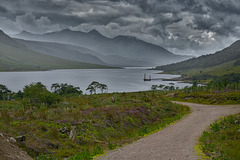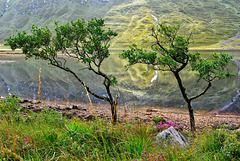
Scotland
Folder: Scotland
Snow covered West Lomond on a bright spring mornin…
| |
|
|
|
At 552 metres, West Lomond, part of the West Lomond Hills, is the highest point in the Kingdom of Fife, Scotland. The ruin (Corston Tower) in the green field is the remains of a 16th century tower house.
Leaderfoot Viaduct, Melrose, Scotland (HFF everyon…
| |
|
|
|
The Leaderfoot Viaduct, also known as the Drygrange Viaduct, is a railway viaduct over the River Tweed near Melrose in the Scottish Borders.
The viaduct was opened on 16 November 1863 to carry the Berwickshire Railway, which connected Reston with St Boswells, via Duns and Greenlaw.
The railway was severely damaged by flooding during August 1948, with 7 bridges on the line failing, and the line closed to passenger traffic on 13 August 1948. Freight trains continued to run across the viaduct as far as Greenlaw until 19 July 1965.
In 1981, the poor condition of the viaduct meant that it was due to be demolished. It was upgraded from Category B to A listing in 1986. Historic Scotland took over control of the viaduct from British Rail in 1996.
The viaduct stands 126 feet (38 m) from the floor of the river valley. The arches, each of 43 feet (13 m) span, are of brickwork, and the abutments, piers and walls are of rustic-faced red sandstone. Some later strengthening of the abutments and piers with old rails and buttresses on the southern valley side is very obvious. It is straight over its whole course, and runs in a broadly northerly direction.
It is near to the Roman settlement of Trimontium, which is to the south-west of the viaduct To the east of the viaduct are the Drygrange Old Bridge, a road bridge dating from 1776, (part of the bridge stonework is visible in the right-foreground) and its modern successor. This group of three bridges is sometimes known as Tripontium. To the east of the viaduct the River Leader flows into the Tweed from the north.
The Leaderfoot Viaduct, Melrose, Scottish Boarders
| |
|
|
|
Plus one PiP
The Leaderfoot Viaduct, also known as the Drygrange Viaduct, is a railway viaduct over the River Tweed near Melrose in the Scottish Borders.
The viaduct was opened on 16 November 1863 to carry the Berwickshire Railway, which connected Reston with St Boswells, via Duns and Greenlaw.
The railway was severely damaged by flooding during August 1948, with 7 bridges on the line failing, and the line closed to passenger traffic on 13 August 1948. Freight trains continued to run across the viaduct as far as Greenlaw until 19 July 1965.
In 1981, the poor condition of the viaduct meant that it was due to be demolished. It was upgraded from Category B to A listing in 1986. Historic Scotland took over control of the viaduct from British Rail in 1996.
The viaduct stands 126 feet (38 m) from the floor of the river valley. The arches, each of 43 feet (13 m) span, are of brickwork, and the abutments, piers and walls are of rustic-faced red sandstone. Some later strengthening of the abutments and piers with old rails and buttresses on the southern valley side is very obvious. It is straight over its whole course, and runs in a broadly northerly direction.
It is near to the Roman settlement of Trimontium, which is to the south-west of the viaduct To the east of the viaduct are the Drygrange Old Bridge, a road bridge dating from 1776, (from where this picture was taken) and its modern successor. This group of three bridges is sometimes known as Tripontium. To the east of the viaduct the River Leader flows into the Tweed from the north.
Abandoned Cottage in the Snow
| |
|
|
|
Best enlarged
Taken from the Aberdeen to Inverness train somewhere in Aberdeenshire during a snowstorm - 28th November 1973
Low and slow through Glen Etive, Argyll, Scotland
| |
|
|
|
Best Enlarged
Royal Air Force Airbus A400M Atlas C1 ZM413 of 70 Squadron RAF Brize Norton
Despite the obvious difference in light and cloud cover, these frames are 3 of 14 taken over a period of 17 seconds. Scotland's famous rapidly changing weather in action!
Tranquility....
Blue sky over the road in Glen Etive, Argyll, Scot…
| |
|
|
|
Best enlarged
The cone shaped peaks centre right of picture are; (L to R), Buachaille Etive Beag (958m) and Buachaille Etive Mòr (1022m). In Gaelic the are known respectively as; The little shepherd of Etive and the big shepherd of Etive. The mountain on the right of picture is Beinn Ceitlein (883m), possibly meaning Caitlin's hill.
Morning mist in Glen Ceitlein, Argyll, Scotland
Bright start to the day...
| |
|
|
|
Glen Etive - by dawns early light...
Nature thrives while steel dies
| |
|
|
|
Best enlarged
This is part of a wire fence tensioner device fitted on top of a stone wall, possibly to raise the height of the barrier and prevent red deer present in the area from jumping over the wall. On the other hand, as it was mounted on the wall surrounding the playground of the Glen Etive school house, it may have been put in place to prevent the children absconding at playtime;-))))
The Old School House, Glen Etive, Arygll, Scotland
| |
|
|
|
Best enlarged
Glen Etive School House
Now a holiday cottage (The Old School House). The school house appears on an Ordnance Survey map of 1843 (the earliest I can find) and possibly closed at the time the new Glencoe Primary School opened in 1981. The building appears to have been very well constructed of good stone with walls approximately 60-70 cm thick.
According to local knowledge the school had between 1 and 14 pupils at any one time. The classroom was situated in what is now the kitchen, the teacher and any family would have occupied the upper floor.
The kitchen (classroom) is the only room in the building to have windows in both walls and are positioned quite high up, presumably to stop the children being distracted from their lessons;-) In the front of the school is a small walled grassed area that was, according to local sources, the playground.
Again, according to local sources, in the early 20th century two boys, the McGregors, who lived in a cottage across the River Etive from the school had to cross the river in a 'bucket' suspended on a rope in order to attend the school. Along with their books and their lunch they were also expected to bring a couple of blocks of peat each for the fire! At the time these two boys were the only pupils.
if anyone can add to, or correct the above information I would be happy to hear from them.
Rainbow over the River Etive, Glen Etive, Arygll,…
| |
|
|
|
Best enlarged
The River Etive rises on the peaks surrounding Rannoch Moor, with several tributary streams coming together at the Kings House Hotel, at the head of Glen Coe. The river flows through Glen Etive, draining into Loch Etive.
For white water kayakers, the river is considered to be one of the most challenging white water kayaking routes in Scotland, including grade 4 rapids with a range of waterfalls and pools.
The river was peaceful when this picture was taken. After a period of heave rain the level rises by about a metre over a fairly short period of time resulting in a much more active scene.
A small, single track road runs alongside the river for its 18km course to the loch – this road is widely regarded as one of the most picturesque roads in all of Scotland.
Waterfall on a small stream, Glen Etive, Argyll, S…
| |
|
|
|
Best enlarged
A waterfall of about 4 - 5 metres height on a small stream (Alt nan Gaoirean) feeding into the River Etive in the grounds of the holiday cottage. The focal length used and angle of shot belies the true height. There is a sheer drop of 2 - 3 metres directly into the pool of water below the camera tripod position.
The Approaching Storm - Loch Etive
| |
|
|
|
Loch Etive (Scottish Gaelic, Loch Eite) is a 30 km sea loch in Argyll and Bute, Scotland. It reaches the sea at Connel, 5 km north of Oban. It measures 31.6 km (19 3⁄4 miles) long and from 1.2 km ( 3⁄4 mile) to 1.6 km (1 mi) wide. Its depth varies greatly, up to a maximum of 150 m (490 ft).
Loch Etive Jetty, Glen Etive, Argyll, Scotland (1…
| |
|
|
|
This jetty can be used for the transportation of timber by sea, harvested from the forestry on the hills in Glen Etive. As can be seen from the two pictures, the current jetty is close to the location that the Victorian era jetty would have occupied.
It is perhaps worth noting that in the intervening approximately 130 years between the two pictures, nothing seem seems to have changed on the far shore of the loch.
A steamer, (see PiP) believed to be the "Osian" (1885 - 1913), moored at a pier on Loch Etive. Since 1877 a tour had run from Oban sailing the 17 miles up Loch Etive (via Connell where it opened to the sea), with coach connections to Tyndrum and Ballachulish Railway Stations. From a pier at the north end of Loch Etive tourists were able to link with a carriage service which took them up Glen Etive to see Glen Coe, a distance of some 17-18 miles.
For the Victorian photograph my thanks to Don001 at:
the-lothians.blogspot.co.uk/2012/10/late-victorian-edwardian-era-scottish.html
Lower Glen Etive across Loch Etive, Argyll, Scotla…
| |
|
|
|
Best enlarged
Loch Etive (Scottish Gaelic, Loch Eite) is a 30 km sea loch in Argyll and Bute, Scotland. It reaches the sea at Connel, 5 km north of Oban. It measures 31.6 km (19 3⁄4 miles) long and from 1.2 km ( 3⁄4 mile) to 1.6 km (1 mi) wide. Its depth varies greatly, up to a maximum of 150 m (490 ft).
The River Etive drains into Loch Etive from its source near Kingshouse on Glencoe, Rannoch Moor. A small, single track road runs alongside the river for its 18km course to the loch – this road is widely regarded as one of the most picturesque roads in all of Scotland.
The mountain on the right of picture is Beinn Ceitlein (883m), possibly meaning Caitlin's hill.
By the shore of Loch Etive
| |
|
|
|
Jump to top
RSS feed- Latest items - Subscribe to the latest items added to this album
- ipernity © 2007-2024
- Help & Contact
|
Club news
|
About ipernity
|
History |
ipernity Club & Prices |
Guide of good conduct
Donate | Group guidelines | Privacy policy | Terms of use | Statutes | In memoria -
Facebook
Twitter


















